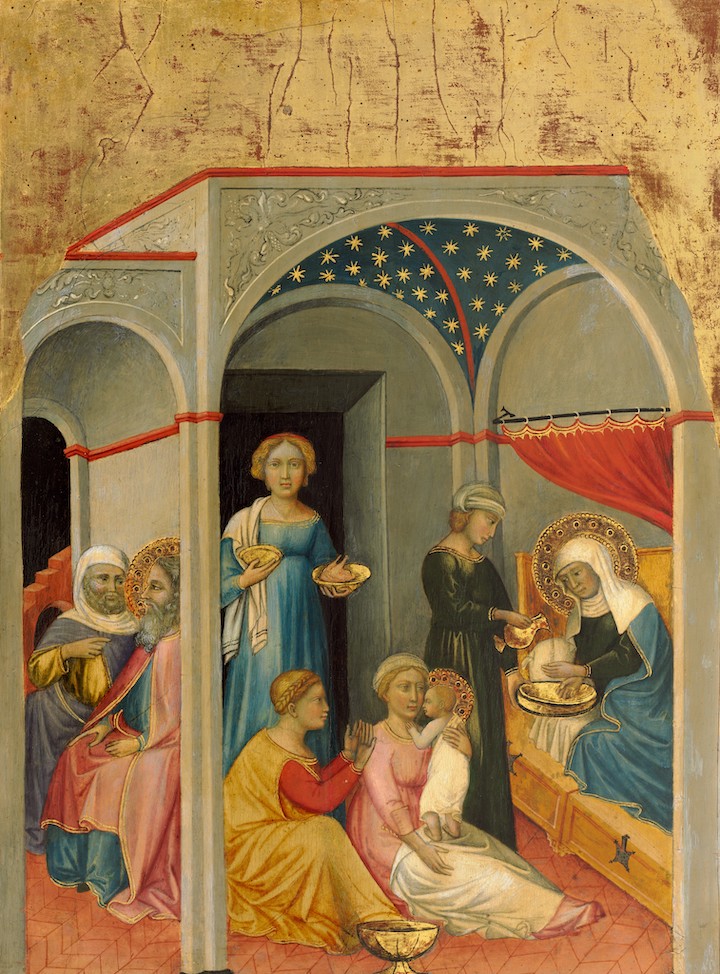We know relatively little of Our Lady’s origins; our information comes mostly from the Protoevangelium of St. James, which contains many pious legends and stories about her parents (Anne and Joachim) and infancy. We know, for a fact, however, that every devout Jewish woman dreamed of being the mother of the Messiah, or at least of giving birth to a daughter who would be.
The Church Universal commemorates Mary’s nativity on September 8. Though the Church normally honors saints on the dates of their death, not their birth, there are three exceptions: Our Lord, Our Lady, and St. John the Baptist. Why those? Because Our Lord and His Blessed Mother were conceived without original sin, while it’s common Catholic belief that the Baptist was born without sin due to his sanctification in the womb at the pregnant Mary’s visitation of Elizabeth, causing John to “leap for joy.” (Luke 1:44)
On this feast, we are presented with Jesus’ genealogy according to St. Matthew (1:1-17) – a rather strange Gospel passage, with even stranger names. Can we make some sense of it?
St. Matthew presents a thoroughly Jewish Jesus, intending to show the continuity between Christianity and Judaism, indeed, the fulfillment of the latter in the former. Therefore, he portrays Jesus as the “new Moses,” the Church as the “new Israel,” and the Gospel as the “new Law.”
He does this in various ways: a five-book structure of his work to parallel the five books of the Torah; frequent use of the number seven; dozens of citations from the Old Testament. But the evangelist Matthew also does something else to make this point and does it so subtly that most readers miss it.
His genealogy powerfully proclaims the Jewishness of Jesus – which definitively announces and demonstrates Jesus is a son of David, from whom the long-awaited Messiah would come, according to the prophets.

Properly to appreciate the genealogy, it’s important to understand that the Jews (like most ancient peoples) had a great fascination with the symbolic value and meaning of numbers. For them, “seven” was the sign of absolute perfection, while “six” epitomized gross imperfection. No surprise, then, that the Messiah’s lineage is broken into three groups of fourteen ancestors (twice the number of perfection and also the numerical value of the letters in David’s name).
This is not “historical” in our modern understanding of the word, especially since there are many gaps. It does not tell us the lineage of the human race from Adam (as in Luke), but from Abraham, the man the Roman Canon calls “our father in faith.” The list is punctuated by important events in Jewish history: the origins of the people, kingship of David, Babylonian exile, coming of the Messiah.
This differs significantly from standard Hebrew genealogies, particularly in that some women are included: Tamar, who seduced her father-in-law Judah into an incestuous union (Genesis 38); Rahab, the chief prostitute of Jericho, who sheltered Joshua’s spies (Joshua 2); Bathsheba, the wife of Uriah who committed adultery with David and then conspired with him to murder her husband (2 Samuel 11); Ruth, the wife of Boaz and daughter-in-law of Naomi, who stands as an exemplar of faithful love and devotion.
The inclusion of these women is notable for several reasons. First, the unsavory nature of most of them (and many of the males as well) is a reminder that we all – the Son of God as well – come into this world with a history. Second, that three of them are not only women but also foreigners points to Jesus’ mission to the Gentiles. Third. in a patriarchal society such as that of the Jews, name and property were passed on through males, not females. So the mention of these women serves as a crucial affirmation of the importance of the woman Mary, “of whom Jesus was born, who is called the Christ.” (Matthew 1:16)
The genealogy is, indeed. Joseph’s, not Mary’s. But while the legal patrimony of Our Lord had to come through a male, His human origins did not – a point made eminently clear by the Evangelist.
St. Matthew wants us to comprehend that salvation history had reached a high-water mark in the birth of Jesus, a new thing that Almighty God had prepared from all eternity, the coming of Emmanuel, God-with-us – the most significant event in history. And it occurred through the agency of a woman, unaided by a man! It’s completely accurate to say that with the advent of God-in-the-flesh, the status of women changed.
“Let it be to me according to your word.” “And the Word became flesh.” Each and every time we imitate our Blessed Mother’s response of faith and trust in God, the Word takes on flesh once more – within us and our world – as He did more than 2000 years ago in the tiny village of Nazareth.
But note: Our Lord’s genealogy did not cease with His conception and birth. Through the grace of Baptism, which makes His redemptive incarnation and paschal mystery available to us, we have the high privilege of standing in that noble line. We show ourselves worthy of that honor by being identified with Jesus’ Mother – who shared the human condition but was so focused on her God that He was able to use her to undo the negative spiral of human history.
As St. John Henry Newman said: “He who charges us with making Mary a divinity, is thereby denying the divinity of Jesus. Such a man does not know what divinity is. . . . To her belongs, as being a creature, a natural claim on our sympathy and familiarity, in that she is nothing else than our fellow. She is our pride. In the poet’s words, ‘Our tainted nature’s solitary boast.’”
May Mary, Mother of Christ and Mother of the Church, intercede with her Son, our Brother, to enable us to respond with faith, hope, and love – to our own troubled moment.
__________















